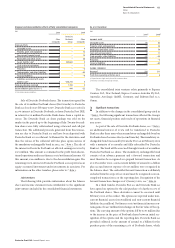DHL 2009 Annual Report Download - page 155
Download and view the complete annual report
Please find page 155 of the 2009 DHL annual report below. You can navigate through the pages in the report by either clicking on the pages listed below, or by using the keyword search tool below to find specific information within the annual report.
Impairment
At each balance sheet date, the carrying amounts of intangi-
ble assets, property, plant and equipment, and investment property
are reviewed for indications of impairment. If there are any such
indications, an impairment test must be carried out. is is done
by determining the recoverable amount of the relevant asset and
comparing it with the carrying amount.
In accordance with , the recoverable amount is the
asset’s fair value less costs to sell or its value in use, whichever is
higher. e value in use is the present value of the pre-tax cash
ows expected to be derived from the asset in future. e discount
rate used is a pre-tax rate of interest re ecting current market
conditions. If the recoverable amount cannot be determined for
an individual asset, the recoverable amount is determined for the
smallest identi able group of assets to which the asset in question
can be allocated and which generates independent cash ows (cash
generating unit – ). If the recoverable amount of an asset is
lower than its carrying amount, an impairment loss is recognised
immediately in respect of the asset. If, a er an impairment loss has
been recognised, a higher recoverable amount is determined for the
asset or the at a later date, the impairment loss is reversed up
to a carrying amount that does not exceed the recoverable amount.
e increased carrying amount attributable to the reversal of the
impairment loss is limited to the carrying amount that would have
been determined (net of amortisation or depreciation) if no im-
pairment loss had been recognised in the past. e reversal of the
impairment loss is recognised in the income statement. Impairment
losses recognised in respect of goodwill may not be reversed.
Since January , goodwill has been accounted for using
the impairment-only approach in accordance with . is
stipulates that goodwill must be subsequently measured at cost, less
any cumulative adjustments from impairment losses. Purchased
goodwill is therefore no longer amortised and instead is tested
for impairment annually in accordance with , regardless of
whether any indication of possible impairment exists, as in the case
of intangible assets with an inde nite useful life. In addition, the
obligation remains to conduct an impairment test if there is any
indication of impairment. Goodwill resulting from company ac-
quisitions is allocated to the identi able groups of assets ( or
groups of ) that are expected to bene t from the synergies of
the acquisition. ese groups represent the lowest reporting level
at which the goodwill is monitored for internal management pur-
poses. e carrying amount of a to which goodwill has been
allocated is tested for impairment annually and whenever there is
an indication that the unit may be impaired. Where impairment
losses are recognised in connection with a to which goodwill
has been allocated, the existing carrying amount of the goodwill
is reduced rst. If the amount of the impairment loss exceeds the
carrying amount of the goodwill, the di erence is allocated to the
remaining non-current assets in the .
Intangible assets are amortised using the straight-line method
over their useful lives. Licences are amortised over the term of the
licence agreement. Capitalised customer relationships are amor-
tised using the straight-line method over a period of to years.
Impairment losses are recognised in accordance with the principles
described in the section headed “Impairment”.
Intangible assets with inde nite useful lives (e. g. brand names)
are not amortised but are tested for impairment annually or when-
ever there are indications of impairment. Impairment testing is car-
ried out in accordance with the principles described in the section
headed “Impairment”.
Property, plant and equipment
Property, plant and equipment is carried at cost, reduced by
accumulated depreciation and valuation allowances. In addition to
direct costs, production cost includes an appropriate share of allo-
cable production overheads. Borrowing costs that can be allocated
directly to the purchase, construction, or manufacture of property,
plant and equipment are capitalised. Value added tax arising in con-
junction with the acquisition or production of items of property,
plant or equipment is included in the cost if it cannot be deducted as
input tax. Depreciation is generally charged using the straight-line
method. e Group uses the estimated useful lives indicated below
for depreciation. If there are indications of impairment, the princi-
ples described in the section headed “Impairment” are applied.
Useful lives
years
2008 2009
Buildings 5 to 50 5 to 50
Technical equipment and machinery 3 to 10 3 to 10
Passenger vehicles 4 to 6 4 to 6
Trucks 5 to 8 5 to 8
Aircraft 15 to 20 15 to 20
Other vehicles 3 to 8 3 to 8
systems 3 to 8 3 to 8
Other operating and o ce equipment 3 to 10 3 to 10
Deutsche Post DHL Annual Report
138
























